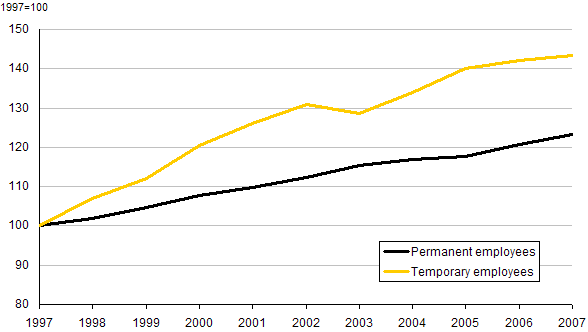Publications
The Canadian Labour Market at a Glance
Employment indexes, by job permanency
Archived Content
Information identified as archived is provided for reference, research or recordkeeping purposes. It is not subject to the Government of Canada Web Standards and has not been altered or updated since it was archived. Please "contact us" to request a format other than those available.
Temporary jobs continue to grow at a faster pace than permanent ones
-
Job permanency—whether or not a job has a predetermined end date—can be used alongside other indicators as a measure of job quality. A permanent job generally tends to be more stable and has higher wages than a temporary job. For example, in 2007, the average hourly wage of permanent employees was $21.07, compared with $15.99 for temporary employees.
-
In 2007, the vast majority of Canadian employees (87.1%) had permanent jobs—with no predetermined end date. Employees with temporary jobs, which include term or contract, casual or seasonal-type jobs, numbered 1.8 million in 2007.
-
The industries with the largest shares of temporary workers in 2007 were agriculture; educational services; information, culture and recreation; business, building and other support services; and construction.
-
Temporary jobs increased at a faster pace than permanent ones from 1997 to 2007 (43.5% versus 23.2%), but in terms of sheer numbers, there were far more permanent jobs added (2.3 million) than temporary ones (559,000). Nevertheless, the share of all employees in temporary jobs has increased to 12.9% in 2007 from 11.3% in 1997.
Chart I.1
Employment indexes, by job permanency, 1997 to 2007

Note: For a definition of an index, please refer to the glossary.
Source: Statistics Canada, Labour Force Survey, CANSIM table 282-0080.
- Date modified:
